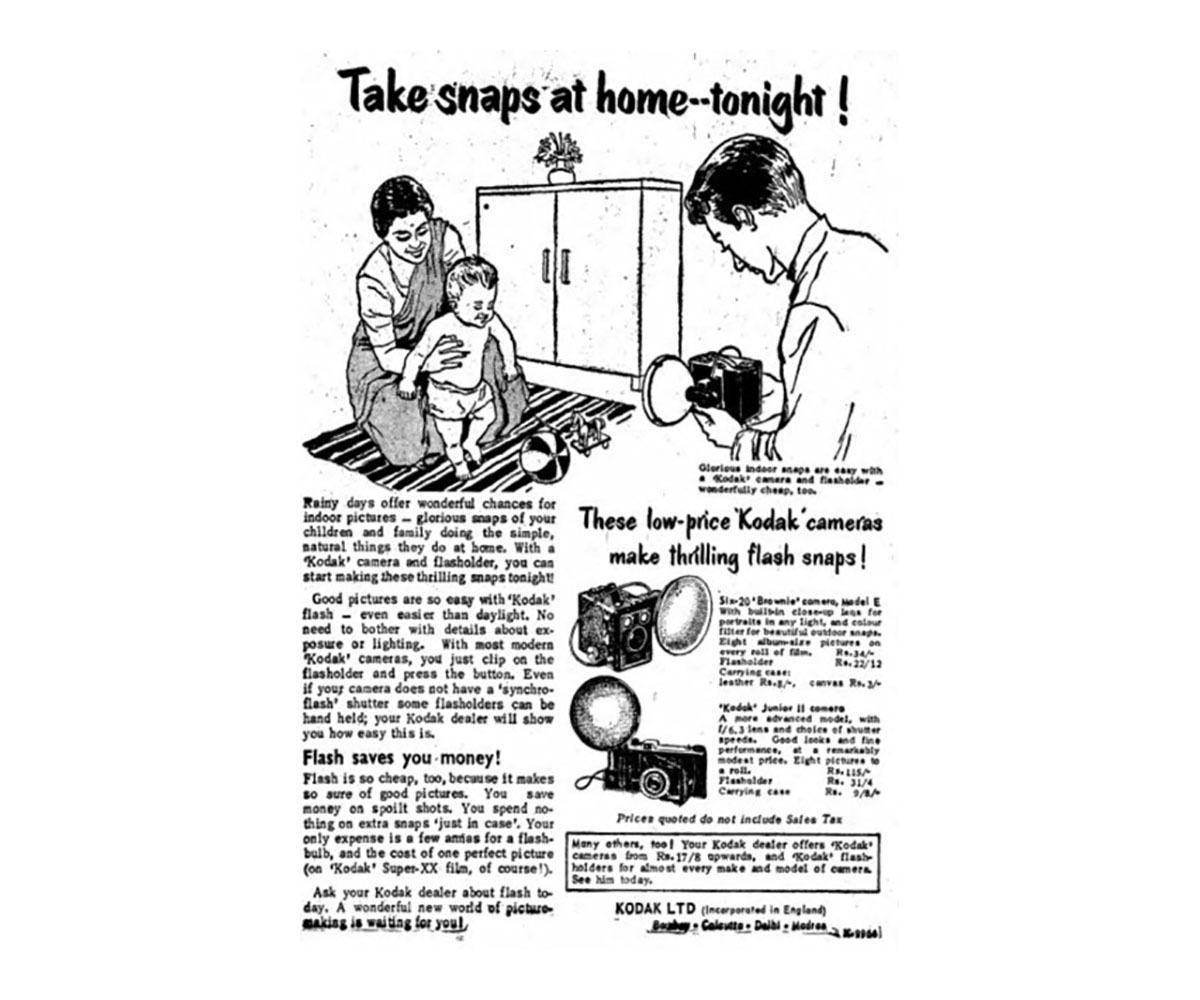PERSPECTIVES
How Kodak Ads Captured the Changing Indian Family
What can the changing trajectory of Kodak advertisements over the years tell us about Indian middle-class families and their patterns of consumption after independence?
The advertisement “Kodak Pictures Tell the Story” published in The Times of India on 26 January 1925 shows a simple black and white line drawing depicting two women holding cameras, engaged in conversation. In the background, a turbaned man sits cross-legged smoking a hookah. The caption reveals that the women – as well as the target viewers of the advertisement – are not Indians but rather tourists or the wives of colonial officials temporarily based in India. The images seem to be compelling the travellers to purchase a Kodak camera to capture the “glorious scenes” and “interesting sights” they encounter during their journeys across India.
Other images from this campaign also incorporated the trope of a European tourist enjoying the subcontinent’s landscapes and encountering figures like craftsmen or Indian women carrying clay pots. As scholar Jennifer Orpana explains, these advertisements “presented Indians as exoticized or essentialized tropes intended to delight Western viewers, highlight differences, mask racial tensions, and naturalize colonial power and presence in India.”
These advertisements were aligned with Kodak’s campaigns in the West, which had featured the figure of the ‘Kodak Girl’ since the early 1900s. At that time, Kodak had begun to produce roll film and cheaper, portable cameras. In response, these advertisements were meant to represent an independent woman at the dawn of a new progressive era ushered in by feminist movements in the West. Women enjoyed more freedom, explored the world and could “take the Kodak” with her on her travels. Featuring this recognisable figure of the ‘Kodak Girl,’ advertisements in India at this time, were intended to appeal to the taste of Western tourists and consumers rather than the native Indian traveller. These advertisements also reflected the role of photography at the time as a powerful tool to further imperialist agendas and meet the growing demand in the West for exoticised images of British colonies and the ‘Orient’.
It was only after India’s independence in 1947 that Kodak’s advertising strategies began to cater to Indian consumers. In 1969, several decades after Kodak Limited was established in Bombay (now Mumbai), the company ran a series of advertisements in The Times of India. These simple black-and-white advertisements all centred around the trope of a typical nuclear family, depicting a father figure photographing his wife and child. In one, we see the mother reading a book with her daughter; in another, a mother holding a baby taking its first steps.
Post-independence advertisements began to consider the shifting socio-political context and new audiences in India, accounting for factors such as race and class. These images now represented patriarchal, nuclear, middle-class families. They introduced the figure of the “father-photographer,” suggesting that it was the responsibility of the father to capture fleeting memories for his family. These images were also strikingly similar to those being circulated by the National Programme for Family Planning which typically depicted a couple with two children, usually a boy and a girl. As the Government made a case for family planning, one of its arguments was that smaller families had more time and resources to focus on their well-being and leisure. In depicting a nuclear family documenting their moments together, these Kodak advertisements were also in conversation with these circulating ideas of what a modern, progressive Indian family should look like.
Moving away from the emphasis on femininity and freedom, Kodak’s advertisement now sought to represent ideals of a new, postcolonial India by marketing photography as a shared domestic and cultural practice — predominantly the domain of the patriarch of the family.
As the modes of capturing daily moments shift in this digital age and access to mobile technologies proliferates across India, Kodak is no longer synonymous with taking family photographs. Even so, its advertisements remain a valuable record of a moment in time when the Indian middle class was in the process of defining its image of modernity.
Bibliography
The Kodak Girl: Women in Kodak Advertising. Toronto Metropolitan University Archives, 2013. Accessed May 10, 2024. https://library.torontomu.ca/asc/2013/10/the-kodak-girl-women-in-kodak-advertising/
Jennifer Orpana, “Finding Family in The Times of India’s Mid-Century Kodak Ads.” Family Photographs 9, no. 1 (2018). https://quod.lib.umich.edu/t/tap/7977573.0009.107/–finding-family-in-the-times-of-indias-mid-century-kodak-c?rgn=main;view=fulltext.












